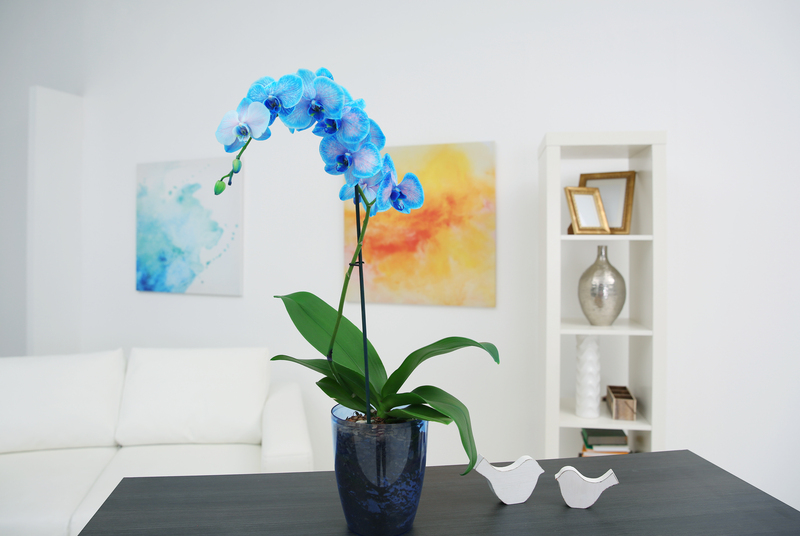Vertical gardening: Nature at new heights
Posted on 14/09/2025
Vertical Gardening: Nature at New Heights
Vertical gardening is a revolutionary approach to modern horticulture, blending creativity, practicality, and sustainability. Whether you're an urban dweller with limited space, or a garden enthusiast eager to maximize your planting area, vertical gardens offer an innovative way to bring greenery into your life. In this comprehensive guide, we'll explore the ins and outs of vertical gardening, including its benefits, types, setup techniques, plant choices, and maintenance tips. Embark on your journey towards nurturing nature at new heights!
What Is Vertical Gardening?
At its core, vertical gardening is the practice of growing plants vertically, often using walls, trellises, or freestanding structures. This technique transforms unused vertical spaces into thriving gardens, allowing you to cultivate everything from flowers and herbs to vegetables and ferns in a compact, visually stunning manner. With vertical gardens, even the smallest balconies, patios, and interiors can burst with lush, living color.
The Rise of Vertical Green Spaces
The surge in popularity of vertical green walls and living panels is driven by modern living constraints, urbanization, and a growing awareness of environmental issues. As city living reduces available land for traditional gardens, vertical solutions make it possible to enjoy gardening almost anywhere. Today, architects and homeowners alike embrace the beauty and functionality of vertical gardens, making them prominent features in homes, offices, and public spaces worldwide.

Benefits of Vertical Gardening
Choosing a vertical garden system offers numerous advantages, both for the environment and for individuals. Here are some of the most compelling benefits of raising your gardening game--literally:
- Space Optimization: Vertical gardens transform walls, fences, and balconies into productive green oases, especially valuable in urban environments.
- Improved Air Quality: Plants filter out pollutants and produce oxygen, enhancing air quality both indoors and out.
- Natural Insulation: Living walls help regulate indoor temperatures, providing insulation and reducing energy costs.
- Biodiversity Support: Vertical plantings create habitats for insects, birds, and pollinators even in densely built cities.
- Aesthetic Value: Vertical gardens are visually appealing, turning bland walls into vibrant artworks.
- Health and Well-being: Interacting with greenery reduces stress, boosts mood, and promotes overall well-being.
- Noise Reduction: Dense foliage can act as a sound buffer, reducing ambient noise in urban settings.
Types of Vertical Gardening
There's no one-size-fits-all approach to vertical gardening. Depending on your space, budget, and aspirations, you can choose from several methods, each with its unique charm. Let's explore the most popular types:
Living Walls / Green Walls
Living walls, or green walls, are perhaps the most striking form of vertical gardening. These large-scale installations cover entire walls with plant life, supported by modular panels, felt pockets, or hydroponic systems. Commonly seen in commercial buildings and luxury hotels, living walls are making their way into homes as impressive, eco-friendly design statements.
Trellises and Lattices
Trellises are classic structures made from wood, metal, or plastic, designed to support climbers like ivy, roses, or grapes. Whether freestanding or attached to a fence or wall, trellises provide both functional and decorative value. Lattices work similarly, often doubling as privacy screens or garden dividers.
Vertical Planters and Pockets
For smaller spaces or DIY enthusiasts, vertical planters or fabric pockets offer an easy, budget-friendly option. These systems--sometimes resembling shoe organizers--can be hung on walls, balconies, or fences and accommodate herbs, small veggies, or succulents. Many retailers now offer stylish, modular vertical planter kits suitable for any decor.
Stacked Containers
Stacked pots or containers utilize vertical shelves or towers to create tiered gardens, ideal for balconies, patios, or indoor gardens. These allow you to grow a variety of plants in limited square footage, and they're portable and customizable for different plant needs.
Hydroponic Towers
Hydroponic vertical gardens use nutrient-rich water instead of soil, allowing for faster plant growth and easy maintenance. These towers are perfect for growing vegetables and leafy greens indoors and are popular among urban gardeners seeking efficient, high-yield solutions.
How to Start Your Own Vertical Garden
Ready to create your own slice of nature at new heights? Here's a step-by-step guide to help you begin your vertical gardening adventure:
1. Assess Your Space
- Indoors: Look for walls with sufficient natural light or space for adjustable grow lights.
- Outdoors: Consider your climate, sun exposure, prevailing winds, and available walls or fencing.
2. Choose Your Structure
- Decide between living wall panels, trellises, hanging pots, modular pockets, or stacked planters.
- Factor in your budget, the weight your wall can hold, and aesthetic preferences.
3. Select Suitable Plants
- Choose plants adapted to your available light and climate conditions.
- Decide if you want a decorative garden (ferns, succulents, flowering vines) or an edible one (herbs, strawberries, leafy greens).
- Consider plant size, root depth, growth habits, and maintenance needs.
4. Plan Irrigation and Drainage
- Vertical gardens dry out faster than traditional beds, so consistent watering is crucial.
- Install drip irrigation or self-watering systems for large walls, or water small planters manually.
- Ensure your setup has proper drainage to prevent root rot and water damage to walls.
5. Install Your Vertical Garden
- Assemble your chosen structure securely.
- Fill containers or pockets with a suitable potting mix.
- Plant your selections closely, considering their mature size.
- Water thoroughly and check for leaks if indoors.
6. Maintain and Enjoy
- Regularly water, prune, and fertilize your plants.
- Monitor for pests, disease, and wilting.
- Reap the rewards of your elevated garden!
Choosing the Best Plants for Vertical Gardening
The success of your vertical garden hinges on selecting the right plants. Ideally, they should have shallow roots, be lightweight, and thrive in the available light and space. Here's a breakdown of fantastic plant choices:
Ornamental Plants
- Ferns: Boston fern, maidenhair, or bird's nest ferns for lush, feathery foliage.
- Succulents: Jade plant, echeveria, and sedum are low-maintenance and excellent for sunny spots.
- Flowering plants: Petunias, pansies, impatiens, begonias, and nasturtiums add vibrant color.
- Climbing vines: English ivy, philodendron, pothos, and creeping fig easily scale trellises and cascade down walls.
Edible Options
- Herbs: Basil, thyme, cilantro, parsley, mint, oregano, and chives are vertical gardening favorites.
- Leafy greens: Lettuce, spinach, arugula, and Swiss chard are productive and quick-growing.
- Strawberries: Ideal for vertical pockets and containers, with attractive foliage and sweet fruit.
- Dwarf varieties: Cherry tomatoes, bush beans, and peppers can thrive in larger vertical setups.
Design Ideas for Striking Vertical Gardens
Unleash your creativity and personalize your vertical gardening project with these design inspirations:
- Living walls as decor: Frame a living wall as a dynamic, ever-changing piece of art in your living room or foyer.
- Edible kitchen walls: Hang herb-filled pockets in your kitchen for fresh ingredients at your fingertips.
- Outdoor privacy screens: Use climbing vines on trellises to create natural barriers on patios and balconies.
- Color-coded patterns: Arrange flowering plants or foliage in geometric designs for visual impact.
- Repurposed materials: Turn pallets, ladders, or gutters into customized vertical planters.
- Water features: Integrate a small fountain or cascading water element for a soothing, sensorial retreat.
Maintenance Tips for Healthy Vertical Gardens
Keeping your vertical garden thriving requires regular attention and the right care practices:
- Consistent watering: Vertical systems dry quickly. Check soil moisture daily in warm months.
- Fertilize thoughtfully: Use slow-release or liquid fertilizers tailored to your plant choices. Avoid overfeeding.
- Pruning and harvesting: Regularly pinch, prune, or harvest plants to promote growth and maintain shape.
- Monitor for pests: Vertical gardens are less susceptible to some pests, but inspect leaves and stems regularly.
- Replace weak plants: Swap out struggling specimens promptly to prevent disease and encourage healthy display.
Sustainability and the Future of Vertical Gardening
Vertical gardening represents more than a gardening trend--it's a building block for sustainable, future-forward urban environments. By maximizing greenery in cities, vertical gardens help offset carbon emissions, cool urban heat islands, and support local ecosystems. Architects increasingly incorporate green facades and living roofs in their designs to create healthier, more resilient cities. On a personal level, growing your own produce--and reducing food miles--makes a small but meaningful contribution to environmental stewardship.
Common Challenges and Solutions
No gardening method is without obstacles. Here are some typical challenges with upright gardening systems--and how to overcome them:
- Drying out fast: Address with self-watering planters, hydrogel crystals in the soil, or automated drip irrigation.
- Structural issues: Ensure robust installation, especially for large living walls. Consult with experts if needed.
- Poor drainage: Double-check planter design and avoid waterlogged soil to prevent root diseases.
- Limited plant selection: Experiment with hybrids or trailing versions of your favorite plants, or mix plant types for year-round appeal.
- Sunlight limitations: Use grow lights for indoor gardens, or rotate plants seasonally in outdoor setups.

Frequently Asked Questions about Vertical Gardening
Is vertical gardening suitable for beginners?
Absolutely! Many wall planters and pocket systems are easy to set up and maintain, making vertical gardening an excellent choice for novice and experienced gardeners alike.
Can I grow food in a vertical garden?
Yes, from herbs and greens to smaller fruits like strawberries and cherry tomatoes, vertical gardens are perfect for cultivating edible plants at home.
How much maintenance does a living wall require?
Maintenance varies by size and structure, but regular watering, pruning, monitoring for pests, and occasional replanting are essential. Automated irrigation systems can reduce workload for larger installations.
Are vertical gardens expensive?
Costs range widely. DIY vertical planters can be created from upcycled materials on a budget, while custom-designed living walls are a premium investment. However, the visual and environmental returns are well worth considering.
Conclusion: Embrace Vertical Gardening for Greener Living
In a world where space is at a premium and the need for environmental action grows stronger every day, vertical gardening stands out as a creative, practical, and sustainable solution. By harnessing the power of vertical space, anyone--from apartment dwellers to seasoned horticulturists--can bring nature to new heights. Whether your goal is to create a lush green oasis, grow fresh produce, or simply enhance your surroundings, vertical gardening offers endless possibilities. Get started today, and transform your walls from plain backdrops into vibrant, living masterpieces!
Ready to reach new heights with your garden? Let your imagination--and your plants--climb to new levels with vertical gardening!

